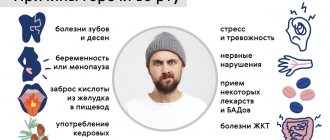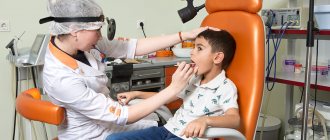Dry throat is one of the most unpleasant symptoms indicating diseases of the nasopharynx and sluggish painful processes inside the body. This is a fairly broad symptom that accompanies many diseases - from the common cold and ARVI to an acute allergic reaction or diabetes. Despite its apparent insignificance, a dry throat can be a marker indicating the presence of serious health problems. A patient suffering from a dry throat becomes more irritable and psychologically susceptible to pathogens, provoking the appearance of increasingly painful reactions.
Dry throat - symptoms of the phenomenon
Dry throat is a rather vague formulation; the main symptoms of this painful process can be several factors from this list:
- General feeling of fatigue, weakness.
- Hoarse voice, tension in the vocal cords.
- Pain in the throat muscles, worse when talking.
- A painful dry cough during which no mucus is coughed up.
- An increase in temperature due to the body's immune response.
- Enlarged tonsils and severe redness.
In addition, dry throat is often accompanied by symptoms that accompany a cold - such as a runny nose, swollen lymph nodes, and pronounced inflammatory processes.
Literature
- I. N. Zakharova, N. A. Korovina. A sore throat. Medical advice. No. 2, 2013, pp. 70-76.
- I. B. Angotoeva. Differential diagnosis of sore throat. Medical advice. No. 15, 2014, pp. 42-46.
- S. V. Ryazantsev. Etiopathogenetic therapy of acute pharyngitis. Consilium Medicum. No. 10, 2007, pp. 64-67
- Instructions for use of the drug HEXORAL® solution.
- Instructions for use of the drug HEXORAL® aerosol.
- Instructions for use of the drug HEXORAL® aerosol for the whole family.
- Instructions for use of the drug HEXORAL®TABS.
- Instructions for use of the drug HEXORAL®CLASSIC.
- Instructions for use of the drug HEXORAL®TABS EXTRA (from 12 years and older).
Dry throat due to bacterial infections
One of the most common causes of dry throat. Infectious diseases accompanied by fever, cough, runny nose and other unpleasant symptoms most often cause a feeling of dry mouth due to damage to the soft tissues of the oral mucosa. In this case, it is unnecessary to fight dry mouth - you need to eliminate the cause of the disease, not its symptoms. By focusing on fighting the infection with antibiotics and other medications, you will not only increase the body's resistance level, but also get rid of all unpleasant symptoms in one go.
Osteochondrosis and discomfort in the esophagus
Lump in the esophagus due to a problem with the thyroid gland
The not entirely clear connection between a spinal pathology such as cervical osteochondrosis and a lump in the esophagus can be explained by the fact that compression of the nerve roots by overgrown osteophytes on the vertebrae can occur throughout the entire periphery of the human body. The cervical spine bears a considerable load; it is one of the most vulnerable due to the constant mobility of its vertebrae.
Lack of physical activity with a sedentary lifestyle, spending a long time in static positions, exceeding the optimal body weight can lead to the fact that osteochondrosis manifests itself even in adolescence. The nerve endings of the cervical spine, damaged by osteochondrosis, cannot fully innervate the chest area, which leads to the sensation of a lump in the esophagus.
This pathology is accompanied by headaches, limitation of movements and pain when turning the head, moving the arms, or bending the neck. A neurologist or vertebrologist will help establish the correct diagnosis and prescribe treatment.
Smoking
Unfortunately, despite numerous warnings from the Ministry of Health, there are still a lot of people who smoke in Russia. Over many years of addiction, they become accustomed not only to the dubious taste of tobacco, but also to the symptoms accompanying its use - a feeling of bitterness, cough, dry mouth. The complete disappearance of dry mouth in a smoking patient is almost impossible - constant inhalation of hot smoke dries out the mucous membrane and leads to the formation of dense lumps of mucus, making swallowing and breathing difficult. If the patient is not ready to give up a bad habit, but wants to get rid of an unpleasant symptom, tissue mineral therapy is carried out - the oral mucosa is moisturized and cleansed, accumulated sputum and mucus are dissolved and disinfected by medication, after which the patient experiences relief and is relieved for a while from a constant feeling of dryness in the throat.
Acute tonsillitis
Tonsillitis, or tonsillitis, is an infectious disease that results in acute inflammation of the tonsils. This is not only a very unpleasant disease in terms of its course, but also a very contagious phenomenon - you can get a sore throat simply by airborne droplets from any unsuccessful contact with an infected person. Inflammatory processes in the nasopharynx lead to severe dryness in the throat. As with colds, to get rid of a dry throat with a sore throat, you should treat the cause of the disease, not its symptom.
Differences from the subatrophic form
Subatrophic pharyngitis, the symptoms of which are minor, is the initial stage of atrophic pathology. There is no thinning or irreversible change in tissue yet. Subatrophic pharyngitis is dangerous because pronounced symptoms do not always appear, which is why many patients do not seek timely medical help. As a result, the start of therapy occurs at a time when the mucous membranes are already seriously damaged and cannot recover, and as a result, treatment is only supportive.
Pharyngitis
Pharyngitis is an infectious disease that is accompanied by severe damage to the oral mucosa and lymph nodes. Rarely occurs alone - most often pharyngitis is accompanied by acute inflammatory processes. A patient suffering from pharyngitis is faced not only with a dry throat, but also with an unpleasant soreness and tickling, a sensation of a foreign element in the nasopharynx, as well as a general feeling of fatigue and malaise. Most often, to eliminate the unpleasant consequences of pharyngitis, they resort to complex treatment - simultaneously with the use of medications, the patient is prescribed mineral therapy to normalize the condition of the mucous membrane in the pharynx, which is supplemented by herbal medicine (the use of medicinal herbs and infusions to irrigate the affected area of the pharynx).
Structure of the pharynx
The pharynx is divided into 3 sections:
- upper (nasopharynx)
- middle (oropharynx)
- lower (larynx)
This division is very conditional, because There are no clear boundaries between departments. When inflammation occurs, it rarely happens that the inflammatory process is localized in one section; usually infectious processes spread and move throughout all sections of the pharynx5,7
As can be seen in the picture below, the oropharynx is composed of the velopharyngeal arches, the uvula and the soft palate.
Pharyngitis usually affects:
- temples
- tongue
- soft sky
- posterior wall of the pharynx
The doctor uses a spatula to completely examine the pharynx. It is needed to improve visibility of the back of the throat.
The palatine tonsils also become inflamed with pharyngitis, because it is impossible to limit the inflammation process. This widespread nature of inflammation in pharyngitis distinguishes it from tonsillitis, where the tonsils are predominantly affected.
Allergic reaction
An allergic reaction of varying severity is also often the cause of an unpleasant feeling of dryness in the throat. Associated symptoms include difficulty breathing, severe pain when swallowing or breathing, and many other signs. Since at this stage of development of medicine, allergies cannot be treated, but are chronic and haunt the patient throughout life, there are several ways to avoid dry mouth:
- Using antiallergic drugs to relieve allergic reactions.
- Integrated use of mineral therapy and herbal medicine to restore normal functioning of the throat.
- Exotic treatment methods for the restoration of mucous membranes in especially critical cases - laser therapy (in this case, a photosensitive gel is applied to the damaged tissues of the throat, which, under the influence of a laser, releases oxygen and saturates the soft tissues with it, promoting their regeneration and destroying pathogenic bacteria), ultrasound and other treatment methods .
Diagnostics
The main methods for diagnosing the disease are collecting anamnesis and performing pharyngoscopy. However, such a diagnosis is not enough to determine the cause of the pathology. After the diagnosis is made, the doctor refers the patient for examinations in order to identify the factors that led to the pathology. If you look at a photo of a sore throat with atrophied mucous membrane, it will help even a non-specialist to visually recognize the pathology in life.
Without fail, a person is sent for a consultation with a gastroenterologist, since it has been precisely proven that most of the atrophic pathologies of the pharyngeal mucosa develop due to the reflux of acid from the stomach into the esophagus. Sometimes the patient himself does not notice this problem, and only a specialist can determine it.
If no disorders of the gastrointestinal tract are established, a blood test for hormones and a smear to identify pathogenic microflora are indicated. In addition, a referral may be given for an allergy test.
When there is concern that the patient has begun to develop cancer, a biopsy of throat tissue is performed. It can be performed independently or in parallel with pharyngoscopy. Thanks to the procedure, a malignant process can often be detected at an early stage, when therapy is still possible.
Dry throat due to vascular pathologies
Diseases of the circulatory system and vascular pathologies are almost always accompanied by a painful feeling of dryness in the throat. In this case, the most acute symptom of the pathology is treated first. As soon as the danger to human life and health has disappeared, the attending physician can begin to get rid of dry throat. Most often, lymphotropic or capillary therapy is used for this. The essence of these methods is to normalize the functioning of capillaries that provide circulation of blood, lymph and nutrients in the damaged area of the throat. The body is saturated with useful substances, releasing large amounts of oxygen and ozone, which are destructive to most harmful bacteria. At the same time, the therapy is also of a general strengthening nature - it not only relieves the patient of the feeling of dry throat, but also prevents the appearance of similar symptoms for a long time, protecting soft mucous tissues from damage.
Disease prevention
Despite the fact that dry throat itself is not an independent disease (it is just a symptom), it can and should be avoided by promptly implementing a set of preventive measures to maintain the health of the oral mucosa. You can do this as follows:
- Do not neglect daily oral hygiene. When brushing your teeth and gargling, a person easily gets rid of many pathogenic bacteria, which can cause complications and even an infectious disease if not treated properly.
- Monitor the condition of the throat mucosa. If you observe the first signs of dryness or pain, immediately consult your doctor.
- Avoid unhealthy habits, particularly smoking. Stay outdoors more often; if you need to stay indoors for a long time with dry air, use a humidifier.
- Gargle regularly.
- Conduct herbal medicine at home - prepare plant decoctions and natural teas. They have a beneficial effect on the condition of the oral cavity, relieving a person of dry throat even in the bud of the disease.
Which doctor should I contact?
Dry throat is a fairly common symptom, so there is no clear answer to this question. It all depends on your individual clinical picture. However, if you are seriously concerned about a growing symptom and feel severe dryness in your throat, you should immediately visit an otolaryngologist, or ENT specialist - this is the specialist who deals with the treatment of the throat and will be able to advise you both on the treatment of dryness and on further medical specialist .
Dry throat is a dangerous symptom, without proper attention to which a person is recommended to face significant complications. At the first signs of dry throat, we recommend that you immediately consult your doctor to receive qualified medical care.
Call our contact center at 8 (495) 230 03 09 and we will help you make an appointment with a specialist!









